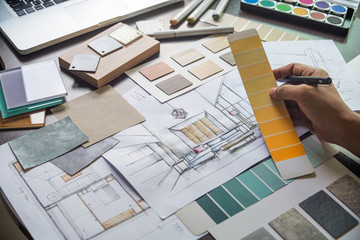What Is Interior Design?
Interior design is a specialized field of architecture that deals with the specific needs and concerns of people who use a space. It involves conceptual development, space planning, and research. Interior designers are trained professionals who can create an outstanding interior environment for a client. Job Description Interior designers design spaces and buildings to enhance the look and functionality of existing spaces and give users access to more comfortable and efficient services.
 The primary role of an interior designer is to determine the current interior settings of a space and how these changes can be incorporated into a building. Interior designers apply art, science, psychology, technology, and many other disciplines of interior design to identify user needs and make a space useful and functional for all people. The designers will also coordinate with architects, builders, interior decorators, and landscape designers to ensure the project’s desired outcome.
The primary role of an interior designer is to determine the current interior settings of a space and how these changes can be incorporated into a building. Interior designers apply art, science, psychology, technology, and many other disciplines of interior design to identify user needs and make a space useful and functional for all people. The designers will also coordinate with architects, builders, interior decorators, and landscape designers to ensure the project’s desired outcome.
Many designers have formal training, including a two-year or four-year degree from an accredited school. Others apprentice with an established designer before going on to practice alone. Interior design is a specialized branch of architecture or environmental design that deals with the planning, design and construction of interior spaces. It involves understanding user behaviors and desires to create functional and aesthetically pleasing spaces.
It also involves designing furniture and accessories that meet the needs of users. It requires good taste and creativity to select the right combination of colors, materials, furniture and decoration that will not only produce a beautiful layout, but will also manage constraints and ensure that it is functional.
The principle of form following function was originally coined by Louis Sullivan in 1896 and is still a staple of many professional interior designers today. It is a principle that allows them to design a space without putting any unnecessary items in it, and it also allows them to spend less on things that will not be useful for long periods of time.
Colors have a powerful influence on our moods. Warm colors like red, yellow and orange can boost our energy levels, while cool colors like blue, green and purple can calm us down and help us feel peaceful and mellow.
The way that colors affect our emotions is often quite complex. They can evoke feelings of excitement or happiness, sadness or indifference, anger or hostility and even anxiety or peace.
In interior design, it’s a good idea to keep this in mind when choosing colors for your home. For example, darker shades of blue tend to be more serious and mature in feeling, while lighter tints of this color can evoke a sense of freedom and vitality.
Creating a mood board is a great way to organize your ideas and ensure that all elements are on point. There are several ways to do this, including making a physical board or using an app such as Milanote, which is an online visual Evernote that allows you to collect images and drag them around for a more free-form layout.
In Interior Design, style is the overall appearance of a space. It is influenced by culture, taste and lifestyle. There are several different interior design styles and each has its own flavor, finish, and experience. It’s important to know what the style is that you want for your home.
For example, you can choose an eclectic style if you like to mix ideas from many different design eras and styles. The result is a rich, mixed home that is unique and inspiring.
You can also choose a minimalist style if you want to create a clean, streamlined look. This style is easy to implement and works well with a neutral color palette.
Space is one of the most important elements of interior design. It combines shape, mass, light, line, pattern, colour and texture to create an ambience in a room.
Residential and commercial spaces have different volumes and forms depending on the preferred style of construction. They provide shelter to people, a sense of belonging and security as well as an opportunity to be creative.
In interior design, space planning is the process of designing a room that meets all its functional requirements. It also considers the psychological needs of those using the space, e.g. a bedroom needs to provide a place for sleeping and studying, while an office space must be conducive to work.


